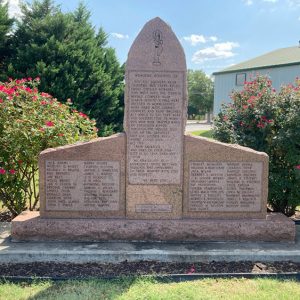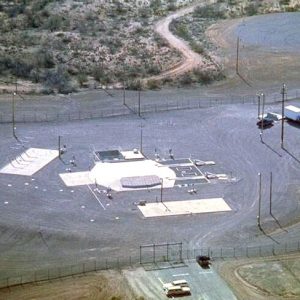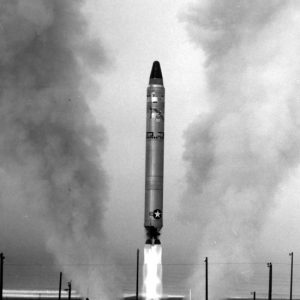calsfoundation@cals.org
Titan II Missile Accident (1965)
Titan II ICBM Launch Complex 373-4 near Searcy (White County) was the site of an accident on August 9, 1965, in which fifty-three workers were killed—the largest loss of life ever suffered in a U.S. nuclear weapons facility.
Titan II ICBM Launch Complex 373-4 was one of eighteen Arkansas launch complexes operated by the 308th Strategic Missile Squadron headquartered at the Little Rock Air Force Base in Jacksonville (Pulaski County). Construction of Launch Complex 373-4 had commenced on January 3, 1961, and was finished on July 31, 1962—the first of the 308th’s sites to be completed and the first to go on alert (meaning that it was fully operational and ready to respond) on May 16, 1963. After it had operated for a few years, the U.S. Air Force initiated Program Yard Fence, in which construction crews were brought in to further gird the facilities against Soviet nuclear attack. During this process, workers improved the launch duct doors and conducted other modifications. The missile at 373-4, fully loaded with fuel and oxidizer although the re-entry vehicle and warhead had been removed, was in the launch duct during the improvements. A four-man air force crew manned the site’s control center while contractors worked in the launch duct.
On August 9, 1965, civilian construction workers were working in all nine levels of the launch duct, painting and flushing the hydraulic systems that operated the steel platforms beside the missile. At about 1:00 p.m. the launch duct was suddenly filled with intense heat and billowing smoke. Gary Lay, a seventeen-year-old who was working his first day at the job, was standing with twelve co-workers on Level 2 when he felt a rush of warm air and turned to see flames behind him. The lights went out, and emergency lights turned on. As the rest of the men rushed toward the emergency escape ladder, Lay instead went through the flames to the cableway leading to the control center, suffering second- and third-degree burns. Another worker, Hubert A. Saunders, who had worked at other launch complexes and knew the layout, made his way from Level 1 to the cableway when he saw smoke and also reached the control center, bringing his paint can and brush with him. Saunders suffered mild smoke inhalation.
Lay and Saunders were the only two of the fifty-five men who were working in the launch duct to survive the fire, which had rapidly sucked all of the oxygen out of the launch duct, asphyxiating fifty-two workers. The fifty-third victim drowned in hydraulic fluid. Air force crews quickly reached the complex and put out a few small fires and began recovering the men’s bodies even as they dealt with another potential catastrophe: When power failed in the launch duct, the air-conditioning turned off, raising temperatures in the silo and creating conditions that could lead to an explosion of the oxidizer within the missile, which had a boiling point of seventy degrees. By 10:00 p.m. the temperature in the launch duct hit eighty degrees. It then began to fall, averting the possibility of a larger accident. The last worker’s body was removed at 5:30 a.m. on August 10.
Investigators determined that a welder working on Level 3 had accidentally hit a hydraulic line with his welding rod, rupturing the hose and causing the spray of hydraulic fuel to catch fire. While attributing the tragedy to human error, the investigators also cited inadequate ventilation in the launch duct, lack of an independent source of power for the silo’s elevator, and absence of alternative exits as contributing factors to the large loss of life in the accident.
Coincidentally, the missile that was in the launch duct, serial number 62-0006, was the same missile that later exploded in Launch Complex 374-7 in Southside (Van Buren County) just north of Damascus (Van Buren and Faulkner counties) on September 19, 1980.
Launch Complex 373-4 returned to alert status on September 29, 1966. As the Titan II program was being phased out, it was taken off alert for good on February 18, 1987, after twenty-four years of service. A memorial to those who died in the accident is located at the Jacksonville Museum of Military History.
For additional information:
Anthony, Michael. “The Sleeping Giant: The Effects of Housing Titan II Missiles in Arkansas and Kansas from 1962 to 1987.” MA thesis, University of Arkansas, 2018. Online at https://scholarworks.uark.edu/etd/2808/ (accessed July 6, 2022).
Cold War Resources Associated with the 308th Strategic Missile Wing in Arkansas Multiple-Property Submission Historic Context. On file at Arkansas Historic Preservation Program, Little Rock, Arkansas.
Roberts, Jeanni. “Missile Silo Fire Killed 53.” Arkansas Democrat-Gazette, August 9, 2015, pp. 1A, 10A.
Schlosser, Eric. Command and Control: Nuclear Weapons, the Damascus Accident, and the Illusion of Safety. New York: Penguin, 2013.
Stumpf, David K. Titan II: A History of a Cold War Missile Program. Fayetteville: University of Arkansas Press, 2000.
Ulsperger, Jason. The 53: Rituals, Grief, and a Titan II Missile Disaster. Lanham, MD: Lexington Books, 2022.
Mark K. Christ
Arkansas Historic Preservation Program
 Command and Control
Command and Control Military
Military World War II through the Faubus Era, 1941 through 1967
World War II through the Faubus Era, 1941 through 1967 Titan II Memorial
Titan II Memorial  Titan II Missile Complex
Titan II Missile Complex  Titan II Missile Launch
Titan II Missile Launch 



I was an MFT (early 1963 to mid-1966) assigned to the 373rd. Our crew Capt. Coles, Lt. Davis, and Sgt. DeReinso were on alert that day. Some short time later we were scheduled to pull alert at 373-4 while maintenances people were at the site. It was an experience I’ll never forget, as the BMAT and I went from level to level. The gray-painted support equipment, floors etc. was no more, everything was black soot. The only gray was the imprints of men that had been removed; some imprints showed them just sitting down on equipment platforms. Bless them all.
Does anyone know if there is an official accident report that has ever been released to the public?
My great-grandfather, Aubrey Reynolds, was one of the civilians who lost their lives during this tragedy. Thank you for keeping what happened to them from being lost to history.
I remember this site well. At the time of this accident I was TDY from Vandenberg AFB. Our team of PTS were there to relieve the OB team so they could go to Vandenberg to load and experience a launch of the Titan 2. Myself and Tony Perry were a team of two to go into the silo following the removal of bodies and to connect and vent the pressure from the tanks.
I remember that day. My dad, Tom Glover, worked on the missile sites in Arkansas. He worked at the Little Rock Air Force Base as a electrical civil engineer, and one of his jobs was to perform maintenance work on the missile sites. Thankfully, he was not there. We received so many phone calls from friends and family checking on him. He always said that just a minor mistake could result in a catastrophic event. Fifty-three lives tragically lost.
Yes, I remember pulling alerts there. I was an MFT and have heard whispers of the deceased and a few times valve tags were turned around. Very spooky around the generator. At times, hair would stand up below my helmet near the accumulator rack.